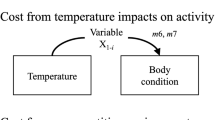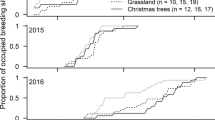Abstract
Preference measures are widely used in habitat selection studies to test an animal’s choice relative to particular habitat features, but most measures are subject to criticism as they fail to indicate the underlying behavioral motivation. Order of settlement on breeding sites has been proposed as an effective measure in migratory organisms, as it conceptually approaches a choice experiment. We tested the assumption that early red-backed shrikes (Lanius collurio) are more willing to defend their territorial resource than individuals arriving later. We earlier showed that shrikes arriving first settled in forest plantations that resulted in lower reproductive success compared to territories on farmland, suggesting an ecological trap. Therefore, individuals are expected to place higher value on the lower quality sites in forests. Within the context of resource valuation theory in animal contests, we used a simulated territorial intrusion experiment to measure territorial defense and to evaluate the perceived value of the territory during the settlement phase in both habitat types. Males arriving early were much more motivated to defend their territory than late birds. After correction for the disparity in the timing of arrival between habitat types, shrikes also more vigorously defended their territories in the forest habitat associated with the lowest reproductive returns. Although some resource valuation mechanisms remain unclear, our results show that early and late-arriving individuals strongly differ in behavioral motivation to hold their territorial resources. This study also demonstrates for the first time that organisms may exhibit a higher degree of territorial aggressiveness in a lower quality habitat.


Similar content being viewed by others
References
Amy M, Sprau P, de Goede P, Naguib M (2010) Effects of personality on territory defence in communication networks: a playback experiment with radio-tagged great tits. Proc R Soc Lond B 277:3685–3692
Arnott G, Elwood RW (2008) Information gathering and decision making about resource value in animal contests. Anim Behav 76:529–542
Battin J (2004) When good animals love bad habitats: ecological traps and the conservation of animal populations. Conserv Biol 18:1482–1491
Becker PH, Dittmann T, Ludwigs J-D, Limmer B, Ludwig SC, Bauch C, Braasch A, Wendeln H (2008) Timing of initial arrival at the breeding site predicts age at first reproduction in a long-lived migratory bird. Proc Natl Acad Sci U S A 105:12349–12352
Brawn JD, Robinson SK, Thompson FR III (2001) The role of disturbance in the ecology and conservation of birds. Annu Rev Ecol Evol Syst 32:251–276
Camfield AF (2006) Resource value affects territorial defense by Broad-tailed and Rufous hummingbirds. J Field Ornithol 77:120–125
Cristol DA (1995) Early arrival, initiation of nesting, and social status: an experimental study of breeding female red-winged blackbirds. Behav Ecol 6:87–93
de Kort SR, Eldermire ERB, Cramer ERA, Vehrencamp SL (2009) The deterrent effect of bird song in territory defense. Behav Ecol 20:200–206
du Bus de Warnaffe GD, Deconchat M (2008) Impact of four silvicultural systems on birds in the Belgian Ardenne: implication for biodiversity in plantation forests. Biodivers Conserv 17:1041–1055
Dale S, Slagsvold T (1995) Female contests for nest sites and mates in the Pied flycatcher Ficedula hypoleuca. Ethology 99:209–222
Dingle H, Drake VA (2007) What is migration? BioScience 57:113–121
Duckworth RA (2006) Aggressive behavior affects selection on morphology by influencing settlement patterns in a passerine bird. Proc R Soc Lond B 273:1789–1795
Fort KT, Otter KA (2004) Territorial breakdown of black-capped chickadees, Poecile atricapillus, in disturbed habitats? Anim Behav 68:407–415
Goymann W (2009) Social modulation of androgens in male birds. Gen Comp Endocrinol 163:149–157
Hof D, Hazlett N (2010) Low-amplitude song predicts attack in a North American wood warbler. Anim Behav 80:821–828
Hollander FA, Van Dyck H, San Martin G, Titeux N (2011) Maladaptive habitat selection of a migratory passerine bird in a human-modified landscape. PLoS One 6:e25703
Holmes RT, Marra PP, Sherry TW (1996) Habitat-specific demography of breeding black-throated blue warblers (Dendroica caerulescens): implications for population dynamics. J Anim Ecol 65:183–195
Hromada M, Antczak M, Valone TJ, Tryjanowski P (2008) Settling decisions and heterospecific social information use in shrikes. PLoS One 3:e3930
Hyman J, Hughes M, Searcy WA, Nowicky S (2004) Individual variation in the strength of territory defense in male song sparrows: correlates of age, territory tenure, and neighbour aggressiveness. Behaviour 141:15–27
Jakober H, Stauber W (1983) Phenology of a population of the red-backed shrike (Lanius collurio). J Ornithol 124:29–46
Jakober H, Stauber W (1994) Copulations and mate guarding in the red-backed shrike Lanius collurio. J Ornithol 135:535–547
Jakober H, Stauber W (2000) Are red-backed shrikes becoming smaller? J Ornithol 141:408–417
Johnsson JI, Carlsson M, Sundström LF (2000) Habitat preference increases territorial defense in brown trout (Salmo trutta). Behav Ecol Sociobiol 48:373–377
Kelly CD (2008) The interrelationships between resource-holding potential, resource-value and reproductive success in territorial males: how much variation can we explain? Behav Ecol Sociobiol 62:855–871
Kenward MG, Roger JH (1997) Small sample inference for fixed effects from restricted maximum likelihood. Biometrics 53:983–997
Kokko H (1999) Competition for early arrival in migratory birds. J Anim Ecol 68:940–950
Kokko H, López-Sepulcre A, Morrell LJ (2006) From hawks and doves to self-consistent games of territorial behavior. Am Nat 167:901–912
Kokko H, Sutherland WJ (2001) Ecological traps in changing environments: ecological and evolutionary consequences of a behaviourally mediated Allee effect. Evol Ecol Res 3:537–551
Kvingedal E, Einum S (2011) Prior residency advantage for Atlantic salmon in the wild: effects of habitat quality. Behav Ecol Sociobiol 65:1295–1303
Lefranc N, Worfolk T (1997) Shrikes: a guide to the shrikes of the world. Pica, Sussex
Lobato E, Moreno J, Merino S, Morales J, Tomás G, Martínez J, Vásquez RA, Kuchar A, Möstl E, Osorno JL (2010) Arrival date and territorial behavior are associated with corticosterone metabolite levels in a migratory bird. J Ornithol 151:587–597
Logue DM, Takahashi AD, Cade WH (2011) Aggressiveness and size: a model and two tests. Am Nat 177:202–210
Marshall MR, Cooper RJ (2004) Territory size of a migratory songbird in response to caterpillar density and foliage structure. Ecology 85:432–445
Marra PP, Hobson KA, Holmes RT (1998) Linking winter and summer events in a migratory bird by using stable-carbon isotopes. Science 282:1884–1886
Mays HL, Hopper KR (2004) Differential responses of yellow-breasted chats, Icteria virens, to male and female conspecific model presentation. Anim Behav 67:21–26
Müller M, Pasinelli G, Schiegg K, Spaar R, Jenni L (2005) Ecological and social effects on reproduction and local recruitment in the red-backed shrike. Oecologia 143:37–50
Paquet J-Y, Vandevyvre X, Delahaye L, Rondeux J (2006) Bird assemblages in a mixed woodland–farmland landscape: the conservation value of silviculture-dependant open areas in plantation forest. For Ecol Manag 227:59–70
Paz Acuña M, Estades CF (2011) Plantation clearcut size and the persistence of early-successional wildlife populations. Biol Conserv 144:1577–1584
Petrusková T, Petrusek A, Pavel V, Fuchs R (2007) Territorial meadow pipits (Anthus pratensis, Passeriformes) become more aggressive in female presence. Naturwissenschaften 94:643–650
Robertson BA, Hutto RL (2006) A framework for understanding ecological traps and an evaluation of existing evidence. Ecology 87:1075–1085
Schaub M, Jakober H, Stauber W (2011) Demographic response to environmental variation in breeding, stopover and non-breeding areas in a migratory passerine. Oecologia 167:445–459
Schlaepfer MA, Runge MC, Sherman PW (2002) Ecological and evolutionary traps. Trends Ecol Evol 17:474–480
Scriba M, Goymann W (2008) The decoy matters! Hormonal and behavioural differences in the reaction of territorial European robins towards stuffed and live decoys. Gen Comp Endocrinol 155:511–516
Skagen SK, Yackel Adams AA (2010) Potential misuse of avian density as a conservation metric. Conserv Biol 25:48–55
Smith RJ, Moore FR (2005) Arrival timing and seasonal reproductive performance in a long-distance migratory landbird. Behav Ecol Sociobiol 57:231–239
Snell-Rood EC, Cristol DA (2005) Prior residence influences contest outcome in flocks of non-breeding birds. Ethology 111:441–454
Söderström B, Karlsson H (2011) Increased reproductive performance of red-backed shrikes Lanius collurio in forest clear-cuts. J Ornithol 152:313–318
Svenning J-C (2002) A review of natural vegetation openness in north-western Europe. Biol Conserv 104:133–148
Thomson RL, Forsman JT, Sarda-Palomera F, Mönkkönen M (2006) Fear factor: prey habitat selection and its consequences in a predation risk landscape. Ecography 29:507–514
Titeux N, Dufrene M, Radoux J, Hirzel AH, Defourny P (2007) Fitness-related parameters improve presence-only distribution modelling for conservation practice: the case of the Red-backed Shrike. Biol Conserv 138:207–223
Tøttrup AP, Klaassen HG, Strandberg R, Thorup K, Willemoes Kristensen M, Søgaard Jørgensen P, Fox J, Afanasyev V, Rahbek C, Alerstam T (2011) The annual cycle of a trans-equatorial Eurasian-African passerine migrant: different spatio-temporal strategies for autumn and spring migration. Proc R Soc Lond B. doi:10.1098/rspb.2011.1323
Tryjanowski P, Hromada M (2005) Do males of the great grey shrike, Lanius excubitor, trade food for extrapair copulations? Anim Behav 69:529–533
Van Horne B (1983) Density as a misleading indicator of habitat quality. J Wildl Manag 47:893–901
Wingfield JC, Hegner RE, Dufty AM, Ball GF (1990) The “challenge hypothesis”: theoretical implications for patterns of testosterone secretion, mating systems and breeding strategies. Am Nat 136:829–846
Acknowledgments
We thank Kate Mitchell and Vanessa Peardon for language editing the final version of this manuscript. F.A.H. was funded by the Belgian National Fund of Scientific Research (FRIA grant). This is publication BRC 246 of the Biodiversity Research Centre (UCL, Louvain-la-Neuve).
Ethical standards
Permission for the use of the mounted specimen was granted by the Walloon Region, Service Public de Wallonie (DNF/DGARNE). The Royal Institute for Natural Sciences of Belgium (IRScNB-KBIN) provided us with a national license for L. collurio trapping.
Conflicts of interest
The authors declare they have no conflicts of interest.
Author information
Authors and Affiliations
Corresponding author
Additional information
Communicated by C. Brown
Rights and permissions
About this article
Cite this article
Hollander, F.A., Titeux, N. & Van Dyck, H. Territorial resource valuation deviates from habitat quality in an ecologically trapped, long-distance migratory bird. Behav Ecol Sociobiol 66, 777–783 (2012). https://doi.org/10.1007/s00265-012-1325-4
Received:
Revised:
Accepted:
Published:
Issue Date:
DOI: https://doi.org/10.1007/s00265-012-1325-4




